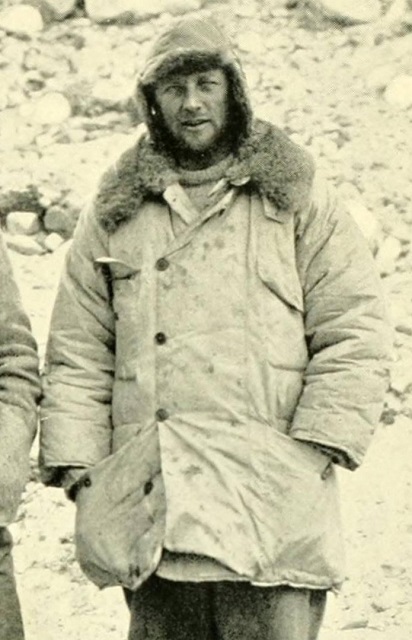George Finch

Biographical information
| Roles | Competed in Olympic Games |
|---|---|
| Sex | Male |
| Full name | George Ingle•Finch |
| Used name | George•Finch |
| Born | 4 August 1888 in Orange, New South Wales (AUS) |
| Died | 22 November 1970 in Wantage, England (GBR) |
| NOC |  Australia Australia |
| Medals | OG |
| Gold | 1 |
| Silver | 0 |
| Bronze | 0 |
| Total | 1 |
Biography
From the age of 14, when he first went up Mount Canobolas near to his home at Orange, in Australia, George Finch knew that he wanted to climb mountains. Shortly afterwards, the family moved to Europe, firstly to Paris where Finch started medical studies at the École de Medicine in Paris, but, after finding physics and chemistry more interesting, he moved to Switzerland where he studied at the Federal Institute of Technology.
Having scaled the walls of the Notre Dame Cathedral under moonlight, as a daredevil stunt with his brother Max during their time in Paris, Finch, living in Switzerland, now had the opportunity to climb some of the great Alpine peaks. Most weekends and holidays, he spent his time climbing in the Alps, and set his sights high right from the start, climbing such memorable peaks as the Eiger and Matterhorn. Being unconventional, Finch normally sought to take more difficult routes up these mountains, and without the aid of professional guides. He also used innovative new techniques and equipment frowned upon by the Alpine Club. These included the used of oxygen filled cylinders for use at high altitude, and a padded jacket he designed for protection from the cold. This was the forerunner of the Puffer jacket,
Finch moved to London in 1913 and got a research job, firstly at the Royal Arsenal and then at the Imperial College, London. When World War I broke out, he volunteered for the Royal Artillery, but did not see action until being sent to Salonika, Greece, in January 1916. His actions in bringing down the German fighter ace Rudolf von Eschwege in 1917 resulted in Finch receiving an MBE. During the Blitz in World War II, he developed a fire-fighting technique that helped London from further damage.
When Finch returned to England after the World War I, he found his new bride had a baby called Peter, born September 1916. It may have been Finch’s, but it could also been that of an India Army Officer, captain Jock Campbell, with whom Finch’s wife Alicia had had an affair. This baby went on to become Hollywood actor Peter Finch and it was not until he was in his mid-40’s that Peter Finch discovered that George Finch was possibly not his biological father, despite being brought up by Finch’s mother in France.
George Finch was chosen for the 1922 Mount Everest Expedition, although it was not a popular choice by many, including the expedition leader Charles Bruce. It was said Finch was not a popular member of the team because he was the only Australian in an all-British (and Gurkhas) group. His unpopularity, however, was probably down to the fact that he was anti-establishment and, unlike the ever-popular George Mallory, was not a Cambridge man. On the expedition, Finch was in charge of the bottled oxygen system he had devised, despite the fact the team leaders were against its use. Finch, and Geoffrey Bruce, cousin of the expedition leader, got to within 530 metres of the summit, however, with the aid of oxygen. It was the nearest the expedition got to the summit.
Finch and Mallory returned to England as national heroes, but in Australia, the achievement only got a brief mention in a couple of regional newspapers. For his part in the expedition, Finch and the team were awarded an Olympic gold medal by Pierre de Coubertin in February 1924. Finch toured Britain and Europe giving talks about the expedition but, because he was loathed by many, including Arthur Hinks, secretary of the Mount Everest Committee, Finch was banned by Hinks from holding these lectures in Europe.
When Edmund Hillary and Sherpa Tenzing Norgay became the first men to eventually conquer Everest in 1953, Hilary was quick to acknowledge Finch and the oxygen equipment they used, which was based on Finch’s original design.
Finch was not chosen for the 1924 Everest expedition, with his place in charge of the oxygen being taken by Sandy Irvine who, with Mallory, got to within a few hundred metres of the summit, before they perished on the mountain. Many wondered how different it would have been had it been Mallory and Finch who made that last push for the summit instead of Mallory and Irvine.
Finch quit climbing in 1931 and concentrated on his career as a scientist and became a professor at the Imperial College and Member of the Royal Society. He was responsible for producing commercial nitrogen fertilizer that would help in food production all over the world. For relaxation, Finch enjoyed nothing more than sailing on British waters with his wife and daughters.
Results
| Games | Discipline (Sport) / Event | NOC / Team | Pos | Medal | As | |
|---|---|---|---|---|---|---|
| 1924 Winter Olympics | Alpinism |  AUS AUS |
George Finch | |||
| Alpinism, Open (Olympic) | Mixed team | 1 | Gold |